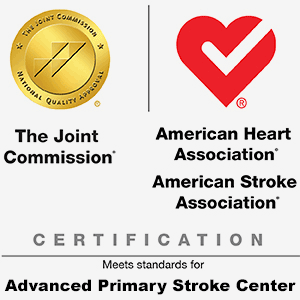Advanced Treatment for Stroke, Aneurysms and Other Neurological Disorders
Spring Valley Hospital offers a wide range of neurological services. These include stroke treatment and diagnosis, and minimally invasive treatments for aneurysms and other complex neurological disorders.
Recognized for Quality
 Spring Valley Hospital Medical Center was the first hospital in southwest Las Vegas to be certified as an Advanced Primary Stroke Center by The Joint Commission. This means that we make exceptional efforts to foster better outcomes for stroke care.
Spring Valley Hospital Medical Center was the first hospital in southwest Las Vegas to be certified as an Advanced Primary Stroke Center by The Joint Commission. This means that we make exceptional efforts to foster better outcomes for stroke care.
Spring Valley also earned the American Heart Association® Get With The Guidelines® Gold Plus Stroke with Honor Roll Elite and Advanced Therapy Award for 2021.
Find a Surgeon
If you need a surgeon or other physician at Spring Valley Hospital, call our free physician referral service at 702-388-4888 or search for a doctor online.
Our Services
Stroke
A stroke occurs when blood flow to the brain is blocked or stopped. Within a few minutes of a stroke, brain cells begin to die. The Centers for Disease Control and Prevention (CDC) reports stroke is the fifth-leading cause of death in the U.S. It is also a major cause of adult disability.
Health issues associated with stroke range from arm or leg weakness after a small stroke to paralysis and loss of speech in larger strokes. For that reason, it is crucial that someone having a stroke receive medical attention as soon as possible.
The American Stroke Association® reminds you to BE FAST if you think you or a loved one is having a stroke:
B ALANCE – Does the person have a sudden loss of balance or coordination?
E YES – Has the person lost vision in one or both eyes or have they had sudden double vision?
F ACE – Ask the person to smile. Does one side of the face droop?
A RMS – Ask the person to raise both arms. Does one arm drift downward?
S PEECH – Ask the person to repeat a simple phrase. Is it slurred or strange?
T IME – Time is critical! If you see any of these signs, call 9-1-1 immediately.
Remember, in an emergency call 911 or get to the nearest emergency room.
Aneurysms
Endovascular surgery is used to treat patients with an aneurysm or weakening of a blood vessel wall. Unlike open surgery, which repairs vessels from the outside through an incision and opening in the bone, endovascular surgery is performed within a blood vessel.
The main purpose of endovascular surgery is to prevent or address a ruptured cerebral aneurysm, which can cause bleeding in the brain. Roughly 30,000 Americans suffer a brain aneurysm rupture every year according to the Brain Aneurysm Foundation.
Brain Tumors
The skull base is extremely delicate because every nerve connects to the brain through this area. It also houses the large blood vessels that supply oxygen to the brain. The most common form of abnormality that would require surgery in this area is a tumor. These tumors are often benign. This is also a common location for an abnormality of a blood vessel or aneurysm.
Skull base neurosurgery typically involves removing the bone at the base of the skull. This is done to expose the tumor or aneurysm with minimal contact with the brain. Otolaryngologists (physicians who treat the ear, nose and throat) and neurosurgeons can remove tumors through the nose. This helps avoid the facial or skull incisions associated with major surgery.
Neurointerventional Radiology Procedures
We perform minimally invasive procedures to treat stroke and other neurological diseases by utilizing neurointerventional radiology procedures in our biplane lab. The biplane imaging services we offer help physicians better predict, diagnose, inform and treat a variety of neurological disorders.
Individual results may vary. There are risks associated with any surgical procedure. Talk with your doctor about these risks to find out if minimally invasive surgery is right for you.
